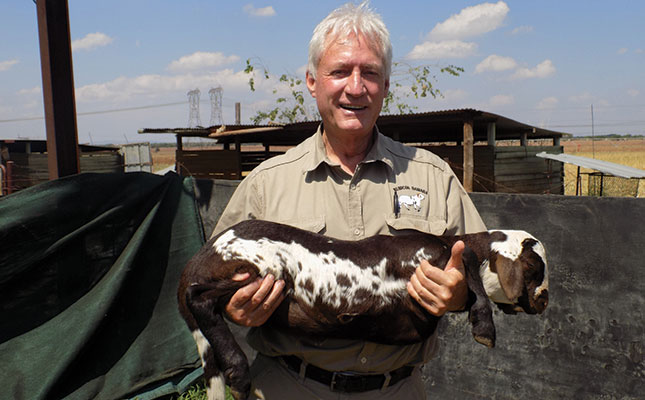[ad_1]
Using sexed semen in a man-made insemination programme carries a 90% assurance that the surrogate animal will ship offspring of the specified intercourse. Annelie Coleman spoke to Damara farmer Stan Burger and embryo-flushing skilled Dr Fanie Steyn in regards to the technical course of and learn how to put together the surrogate ewes.
Photo: Annelie Coleman
The sorting of semen in keeping with gender has introduced nice success for Stan Burger, proprietor of the Rubicon Damara Stud close to Koster in North West. He is the primary Damara breeder on this planet to utilize the most recent semen-sexing know-how.
Burger purchased his first Damaras in 2004 to fight the wattle that coated a lot of his farm.
“These animals eat virtually anything and have, to a great extent, annihilated this invader,” he says.
Burger, who’s president of the Damara Breeders’ Association of South Africa, provides that inventory farmers are more and more recognising the Damara as a worthwhile contender within the sheep-breeding business.

“The breed has retained its robust genetics [over two millennia] and the onus now rests on us as breeders to preserve its pure genetic base. It’s an economical and profitable sheep breed, ideally suited to the challenges of modern-day sheep farming with its increasing input and production costs.”
Sexed semen
According to Burger, utilizing sexed-semen know-how has resulted in fast genetic progress, increased lambing percentages and shorter lambing intervals in his 800-strong Rubicon stud.
“I needed to expand my stud as a matter of urgency because of the sharp increase in demand for top-quality Damara breeding material. But using the traditional approach would have taken far too long.”
Seventy-eight embryos, flushed from 10 chosen Rubicon donor ewes, have been transferred to 48 surrogate ewes on 25 May 2021. This was adopted by the switch of a additional 56 embryos to 33 ewes on 30 June 2021. (The latter ewes have been but to lamb at time of writing.) The egg cells have been fertilised with feminine (X chromosome-bearing) sperm from the ram Rubicon Max.
“From the first 48 ewes, we realised a lamb harvest of 44 ewe lambs and only one ram lamb,” says Burger. “This is a success fee of greater than 98% for sexed semen and a 60% transplanted embryo survival fee.
“Although the technology is relatively expensive, the benefits by far surpass the cost. It will allow me to increase my stud to the envisaged 1 800 animals within the next two years.”
Flushing and switch prices amounted to R2 500/ ewe, and the sexed semen value
R360/ straw. Between 5 and 6 straws are used per embryo-donor ewe. Burger
has retained 400 Rubicon Max semen straws and plans to repeat the sexed-semen course of in February and March 2022 in his quest to speed up the scale of his flock with the perfect Damara genetics.
“I prefer to use stud ewes as surrogate mothers. The Damara has a strong flocking instinct and the lambs need to grow up in the flock to learn to adapt and behave according to flock dynamics. The breed’s strong flocking instinct gives the lambs optimal protection, particularly from predation by jackal, and also makes mustering easy,” he provides.
According to Dr Fanie Steyn, a veterinarian and the managing director of embryo flushing and laparoscopic programmes at Ramsem, using conventional semen for synthetic insemination leads to a 50% likelihood of getting both male or feminine offspring. With sexed semen, greater than 90% of the gestating feminine animals will ship a lamb of the breeder’s selection of intercourse.
High-end know-how
“By using the best breeding material, combined with double the number of replacement ewes available for selection, a farmer can achieve a drastic leap in genetic progress,” says Steyn.
“The use of sexed semen is also extremely popular with in-vivo [programmes].”
Ramsem has secured a contract with US firm Sexing Technologies for using its patented SexedULTRA Genesis sorting machine.
“The technique involves staining the sperm [cells] with a fluorescent agent before sorting,” explains Steyn. “The stained pattern is then transferred into the flow-spectrophotometer in droplets, the place every droplet carries a single sperm cell [with either an X or Y chromosome].
“Due to their 4% extra DNA content material, the feminine sperm cells fluoresce greater than the
males when uncovered to mild. This allows the flow-spectrophotometer to tell apart between female and male sperm cells by the use of subtle software program and a laser, and a optimistic or adverse cost is utilized to the stained droplet.
“Male (negatively charged) and female (positively charged) sperm cells are then separated by deflector plates as the stained droplets move through the flow-spectrophotometer, while defective or dead sperm cells are discarded.”
Steyn says these straws comprise a minimal of 90% sperm cells of the chosen intercourse. Samples are taken of every ram earlier than sorting to make sure that the morphology, motility and focus of the semen pattern meet all of the requirements of Sexing Technologies for profitable sorting on the Genesis machine.
“The initial collection of a semen sample, called a clean-out (CO), takes place seven to 14 days before the desired sorting date. “If the quality of the semen is not up to standard, another ejaculate will be examined or another arrangement made.”
The COs will be carried out on-farm by Ramsem-approved veterinarians two weeks previous to transferring a ram into the station. Sexed semen straws comprise a considerably decrease focus of sperm cells (two to 4 million every) than do conventional semen straws (15 to twenty million every), as a lot of the faulty or useless sperm are eliminated throughout the sorting course of. For this cause, the conception charges of sexed and standard semen are related.
“Most sexed semen is available in straws of two million sperm [cells],” explains Steyn.
“With the brand new 4 million (SexedULTRA 4M) straws, the focus of semen is doubled, which may result in a 7% enhance [in] conception when utilizing frozen semen.
“There’s also the option of fresh sex-sorted semen, either at two million or four million concentrations. Further advances in the fresh semen extender allow for a holding period of up to 72 hours after collection of fresh semen samples.”
Burger stresses that donor ewes needs to be in good situation and in a weight-gaining section earlier than getting into the oestrus synchronisation programme. In this programme, hormones are used to induce fertility throughout a particular interval. Burger maintains this weight-gain section meticulously, offering the ewes with teff and a excessive protein and power ration, till the embryos are transferred laparoscopically into the surrogate ewes.
After implantation, the surrogate ewes are saved in a stress-free surroundings and on the identical ration for six weeks to make sure that the utmost variety of embryos take.
The ewes are then returned to their regular pastures. In the case of Rubicon, the surrogate ewes are taken to inexperienced oat pastures one week earlier than they lamb, and stay there till after lambing. The lambs are weighed and tagged throughout the first 24 hours of their lives and moved again to intensive pastures with the ewes after two weeks.
Email Stan Burger at [email protected], or Dr Fanie Steyn at [email protected].
[ad_2]
Source link










